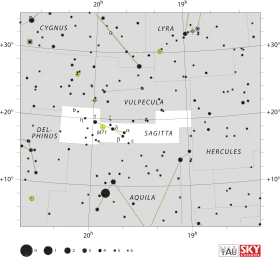Beta Sagittae
Beta Sagittae (β Sagittae / β Sge) est une étoile unique[12] de la constellation boréale de la Flèche. C'est une étoile faible mais visible à l’œil nu avec une magnitude apparente visuelle de 4,38[2]. Sur la base d'une parallaxe annuelle de 7,42 mas mesurée par le satellite Hipparcos[1], elle est située à environ 440 années-lumière du Soleil. L'étoile se rapproche du Soleil avec une vitesse radiale de −22 km/s[5].
| Ascension droite | 19h 41m 02,93907s[1] |
|---|---|
| Déclinaison | +17° 28′ 33,7528″[1] |
| Constellation | Flèche |
| Magnitude apparente | 4,38[2] |
Localisation dans la constellation : Flèche  | |
| Type spectral | G8 IIIa CN 0.5[3] |
|---|---|
| Indice U-B | +0,89[4] |
| Indice B-V | +1,05[4] |
| Indice R-I | +0,50[4] |
| Vitesse radiale | −22,0 ± 0,3 km/s[5] |
|---|---|
| Mouvement propre |
μα = 8,74 mas/a[1] μδ = −33,41 mas/a[1] |
| Parallaxe | 7,42 ± 0,26 mas[1] |
| Distance |
440 ± 20 al (135 ± 5 pc) |
| Magnitude absolue |
−1,39+0,22 −0,20[6] |
| Masse | 4,33 M☉[7] |
|---|---|
| Rayon | 27 ± 3 R☉[8] |
| Gravité de surface (log g) | 2,79[6] |
| Luminosité | 392 L☉[9] |
| Température | 4 850 K[6] |
| Métallicité | −0,03[6] |
| Rotation | 9,1 ± 0,7 km/s[6] |
| Âge | 129 × 106 a[10] |
Autres désignations
β Sge, 6 Sge (Flamsteed), BD+17°4048, FK5 1513, HD 185958, HIP 96837, HR 7488, SAO 105133, GC 27236, PPM 136766[11]
C'est une géante rouge[10] évoluée de type spectral G8 IIIa CN 0.5[3]. La notation en suffixe « CN 0.5 » indique une surabondance modérée de la molécule du cyanogène dans son spectre. L'âge de Beta Sagittae est estimé à 129 millions d'années, sa masse vaut 4,33 fois celle du Soleil[7] et elle s'est étendue jusqu'à faire 27 fois le rayon du Soleil[8]. L'étoile émet 392 fois la luminosité du Soleil[9] depuis sa photosphère étendue à une température effective de 4850 K[6].
Désignations
En chinois, 左旗 (Zuǒ Qí), signifiant Drapeau Gauche, fait référence à un astérisme constitué de β Sagittae, α Sagittae, δ Sagittae, ζ Sagittae, γ Sagittae, 13 Sagittae, 11 Sagittae, 14 Sagittae et ρ Aquilae. Par conséquent, β Sagittae elle-même est appelée 左旗二 (Zuǒ Qí èr, la seconde [étoile] du Drapeau Gauche)[13].
Références
- (en) F. van Leeuwen, « Validation of the new Hipparcos reduction », Astronomy & Astrophysics, vol. 474, no 2, , p. 653 (DOI 10.1051/0004-6361:20078357, Bibcode 2007A&A...474..653V, arXiv 0708.1752)
- (en) J. D. Fernie, « New UBVRI photometry for 900 supergiants », The Astrophysical Journal Supplement Series, vol. 52, , p. 7–22 (DOI 10.1086/190856, Bibcode 1983ApJS...52....7F)
- (en) Philip C. Keenan et Raymond C. McNeil, « The Perkins catalog of revised MK types for the cooler stars », The Astrophysical Journal Supplement Series, vol. 71, , p. 245 (DOI 10.1086/191373, Bibcode 1989ApJS...71..245K)
- (en) D. Hoffleit et W. H. Warren, Jr., The Bright Star Catalogue, CDS. Voir HR 7488 sur la base de données VizieR.
- (en) G. A. Gontcharov, « Pulkovo Compilation of Radial Velocities for 35495 Hipparcos stars in a common system », Astronomy Letters, vol. 32, no 11, , p. 759–771 (DOI 10.1134/S1063773706110065, Bibcode 2006AstL...32..759G, arXiv 1606.08053)
- (en) Bruce W. Carney et al., « Rotation and Macroturbulence in Metal-Poor Field Red Giant and Red Horizontal Branch Stars », The Astronomical Journal, vol. 135, no 3, , p. 892–906 (DOI 10.1088/0004-6256/135/3/892, Bibcode 2008AJ....135..892C, arXiv 0711.4984)
- (en) Y. J. Liu et al., « The Lithium Abundances of a Large Sample of Red Giants », The Astrophysical Journal, vol. 785, no 2, , p. 12 (DOI 10.1088/0004-637X/785/2/94, Bibcode 2014ApJ...785...94L, arXiv 1404.1687)
- (en) G. T. Van Belle, M. J. Creech-Eakman et A. Hart, « Supergiant temperatures and linear radii from near-infrared interferometry », Monthly Notices of the Royal Astronomical Society, vol. 394, no 4, , p. 1925 (DOI 10.1111/j.1365-2966.2008.14146.x, Bibcode 2009MNRAS.394.1925V, arXiv 0811.4239)
- (en) I. McDonald, A. A. Zijlstra et M. L. Boyer, « Fundamental parameters and infrared excesses of Hipparcos stars », Monthly Notices of the Royal Astronomical Society, vol. 427, , p. 343 (DOI 10.1111/j.1365-2966.2012.21873.x, Bibcode 2012MNRAS.427..343M, arXiv 1208.2037)
- (en) Yoichi Takeda et Akito Tajitsu, « Spectroscopic study on the beryllium abundances of red giant stars », Publications of the Astronomical Society of Japan, vol. 66, no 5, , p. 91 (DOI 10.1093/pasj/psu066, Bibcode 2014PASJ...66...91T, arXiv 1406.7066)
- (en) bet Sge sur la base de données Simbad du Centre de données astronomiques de Strasbourg.
- (en) P. P. Eggleton et A. A. Tokovinin, « A catalogue of multiplicity among bright stellar systems », Monthly Notices of the Royal Astronomical Society, vol. 389, no 2, , p. 869–879 (DOI 10.1111/j.1365-2966.2008.13596.x, Bibcode 2008MNRAS.389..869E, arXiv 0806.2878)
- (zh) AEEA (Activities of Exhibition and Education in Astronomy) 天文教育資訊網 2006 年 7 月 3 日